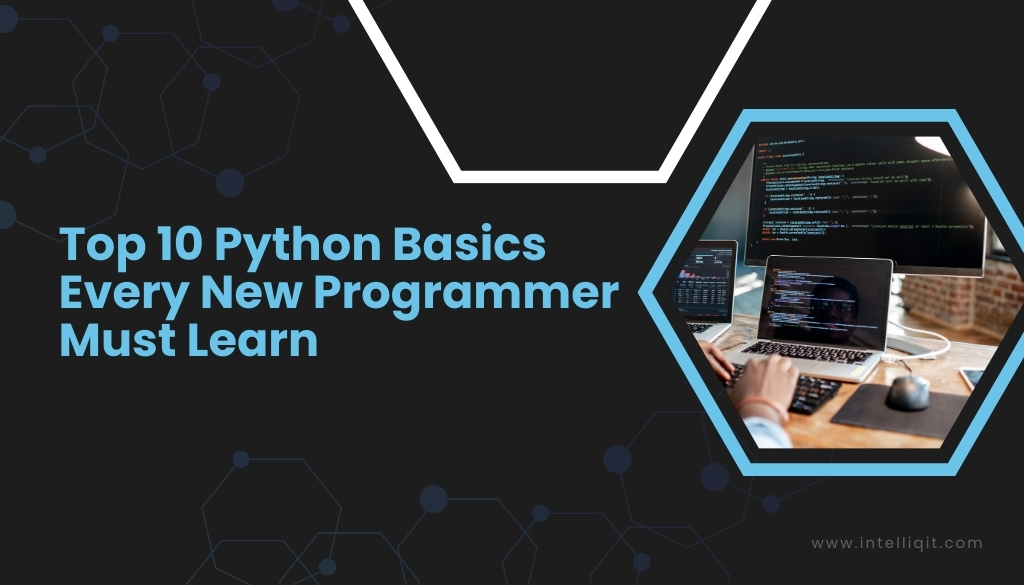Table of Contents
- Introduction
- Why Learn Python?
- Importance of Python Basics
- Setting Up Python
- Installing Python on Windows, Mac, and Linux
- Choosing the Right IDE (PyCharm, VS Code, Jupyter, etc.)
- Python Syntax and Indentation
- The Role of Indentation in Python
- Writing Your First Python Program
- Variables and Data Types
- Declaring Variables
- Numbers, Strings, Booleans
- Type Conversion
- Operators in Python
- Arithmetic Operators
- Comparison Operators
- Logical and Assignment Operators
- Control Flow Statements
- If, Elif, Else Statements
- Loops (for, while)
- break and continue
- Functions in Python
- Defining Functions
- Parameters and Return Values
- Built-in Functions vs User-Defined
- Data Structures
- Lists and Tuples
- Dictionaries and Sets
- Common Methods and Operations
- Strings in Python
- String Formatting
- String Methods (split, join, replace, etc.)
- f-Strings and Concatenation
- Input and Output
- Taking User Input
- Printing Output
- Reading and Writing Files
- Error Handling
- Understanding Errors and Exceptions
- Try, Except, Finally Blocks
- Conclusion
- Summary of Python Basics
- Next Steps for Learning (OOP, Modules, Libraries)
Introduction:
Python is a popular programming language used all over the world, and this popularity is quite well deserved. It is easy to understand and easy to write in; thus, it is accessible to novice students and still powerful enough to be used in very advanced domains like Artificial Intelligence, Machine Learning, Web Development, Data Science, and Automation. Python is a perfect programming language to start with, as one does not have to get involved with very many rules and syntax, as is the case with most other languages.

Why Learn Python?
Python has been adopted by most tech giants including Google, Instagram, Netflix, and NASA and hence its realistic use and market marketing is true. The field of study Python provides access to a host of career opportunities, including software development, data mining, artificial intelligence and cloud computing. Having a solid community to support it, numerous resources in the form of libraries available, and regular updates, Python makes sure that students can find the resources and help to enhance their skills at any given moment.
Importance of Python Basics
The person must be familiar with the basic knowledge of Python Basics, and then the higher concepts can be learned. The moment this new learner learns about variables, types of data, operators, and loops together with functions, he/she can write easy yet clean code. These Python basics are the bridges to the higher level of ideas, object-oriented programs and structures. Simple ideas make Python programming a success and long-term confidence.
Setting Up Python:
The initial part is to install Python on your computer system before you can begin the coding process. Fortunately, Python can be installed very easily and can run on all major operating systems. On a Windows operating system, it is possible to download the installer directly from the Python official site and enter the setup wizard. Python may be installed automatically on Mac, but it could be up-to-date in Homebrew. Most of the distributions with Linux typically contain Python. If not installed, installation can be done while using package managers like `apt` or `yum`.
When Python is installed, the second step is to select a suitable Integrated Development Environment (IDE). VS Code tends to be a favourite among novice programmers as it is easy to use and can be used with numerous different extensions. Mostly, the professional programmers will use powerful PyCharm, which has better debug features and project management. The interactivity of Jupyter Notebook has made it a popular data science and machine learning tool. The type of IDE you pick is significant to the learning experience.
Python Syntax and Indentation:
Many other programming languages have extremely complicated syntax that makes them unlike Python. Python uses white spaces or tabs in place of the ‘{}’ braces commonly used by other computer programming languages like Java or C++ as a marker of the code blocks. This type of structure makes Python Basics code very readable, and programmers are expected to write clean code. Four spaces is a standard indent level, and less than that will result in a programmer producing code that crashes.
The Role of Indentation in Python
Indentation is not a style preference in Python but a rule. It informs the interpreter which lines to execute collectively. This makes Python both easy to approach for new users and rigid in code formatting.
Writing Your First Python Program
A simple way to begin is by writing the classic “Hello, World!” program:
Python
Print (“Hello, World!”)
This small step marks the beginning of your Python journey.
Variables and Data Types:
Python variables are also useful in storing information which can be used more than once in a program. In Python Basics, unlike most other programmable languages, there is no special statement to define the type of a variable. Instead, it will automatically drag down a type according to what kind of value you have typed. This endears Python and makes it easy.
Declaring Variables
A variable is created the moment you assign a value to it. For example:
python
name = “Alice”
age = 25
is_student = True
Here, `name`, `age`, and `is_student` are variables holding different types of data.
Numbers, Strings, Booleans
* Numbers: Used for mathematical operations. Example: `x = 10`, `y = 3.5`.
* Strings: Text enclosed in single or double quotes. Example: `message = “Hello”`.
* Booleans: Represent truth values `True` or `False`. Example: `is_active = False`.
Type Conversion
Python allows you to convert variables from one type to another using functions like `int()`, `float()`, and `str()`.
“`python
x = “100”
y = int(x) # Converts string to integer
Understanding these basics ensures smooth progress as you explore more advanced concepts in Python.
Operators in Python:
Special characters that we use to operate on variables and numbers are called Python operators. They help us perform activities like calculations, comparisons and decision-making in programs.
Arithmetic Operators
These are used for mathematical operations:
* `+` (addition), `-` (subtraction), `*` (multiplication), `/` (division)
* `%` (modulus), “ (exponent), `//` (floor division)
Example:
`python
x, y = 10, 3
print(x + y) # 13
print(x % y) # 1
Comparison Operators
These compare values and return a Boolean (`True` or `False`):
* `==`, `!=`, `>`, `<`, `>=`, `<=`
Logical and Assignment Operators
Logical: `and`, `or`, `not` (combine conditions).
Assignment: `=`, `+=`, `-=`, `*=`, `/=` (assign or update values).
Mastering operators is essential for controlling program flow and performing calculations effectively.
Control Flow Statements
Python control flow statements allow decisions to be made and allow running one line at a time. They help a program to manage its operation and thus make it interactive and dynamic.
# If, Elif, Else Statements
These statements let you execute code only if a condition is true.
“`python
age = 18
if age > 18:
print(“Adult”)
elif age == 18:
print(“Just became an adult”)
Else:
print(“Minor”)
This structure ensures that only one block of code runs based on the given condition.
# Loops (for, while)
Loops are used to repeat actions.
* for loop iterates over a sequence:
“`python
for i in range(5):
print(i)
“`
While loop runs until a condition is false:
“`python
count = 1
while count <= 5:
print(count)
count += 1
break and continue
* break exits the loop immediately.
* continue skips the current iteration and moves to the next.
Mastering control flow statements is key to writing efficient and flexible Python programs.
Functions in Python:
Functions in Python are sections of code that can be reused, developed to run a specified task. Its implementation makes programs more module-based since it makes them highly readable and maintainable. Instead of repeating code, a programmer can define a function once and call upon it whenever needed.
Defining Functions:
In Python, functions are defined using the `def` keyword followed by the function name and parentheses. For example:
python
def greet():
print(“Hello, welcome to Python!”)
You can call this function by simply writing `greet()`.
#Parameters and Return Values
Functions can accept parameters to work with different inputs:
python
def add(a, b):
return a + b
result = add(5, 3)
print(result) # 8
The `return` statement allows the function to send a result back to the caller.
Built-in Functions vs User-Defined Functions
Python offers many built-in functions like `len()`, `print()`, and `sum()` that save time. Programmers write user-defined functions to do certain tasks in their programs. A combination of the two types is effective in increasing productivity and code organization.
Data Structures in Python:
Python data structures serve to keep and process data in a highly efficient way. Data structures aid programmers in having collections of data and operations on collections done easily.
Lists and Tuples
- Liare ordered, mutable collections:
Fruits = ["apple", "banana", "cherry"]fruits.append("orange")- Tuples are ordered but immutable, meaning their elements cannot be changed:
Colours = ("red", "green", "blue")Dictionaries and Sets
- Dictionaries store data in key-value pairs:
student = {"name": "Alice", "age": 20}print(student["name"])- Sets are unordered collections of unique elements:
numbers = {1, 2, 3, 2} # duplicates are removedCommon Methods and Operations
Python provides built-in methods for these structures:
- Lists:
append(),remove(),pop() - Tuples:
count(),index() - Dictionaries:
keys(),values(),items() - Sets:
add(),remove(),union()
These data structures are important to understand, as they are the cornerstone of effective Python programming, and can be used to solve practical problems.
Strings in Python:
One of the most commonly used types of data in Python is strings, which are character sequence representations. They are also dynamic and are built in with a wealth of methods that enable a text to be manipulated very easily and quickly.
String Formatting
String formatting allows creating flexible and readable strings. Python has a number of ways to format strings: placeholder-based formatting using %, format() method use, or f-strings. For example:
name = "Alice"age = 25print(f"My name is {name} and I am {age} years old.")String Methods
Python offers powerful methods to manipulate strings:
Split ()– divides a string into a list based on a delimiter.Join ()– joins elements of a list into a string.Replace ()– replaces a substring with another.
Example:
text = "Hello World"print(text.replace("World", "Python"))f-Strings and Concatenation
F-Strings (formatted string literals) are the preferred way to embed variables directly into strings. Concatenation using + allows combining multiple strings:
greeting = "Hello, " + "Alice"Mastering strings is essential for tasks like file handling, data parsing, and creating user-friendly outputs in Python programs.
Input and Output in Python:
Python programs use input and output operations to control communication between the user and the program. Reading and writing files and printing out input and output are made easy by Python.
Taking User Input
Python provides the input() function to capture input from the user. The data received is always a string by default.
name = input("Enter your name: ")print("Hello, " + name + "!")You can convert the input to other types, such as integers or floats, using int() or float().
Printing Output
The print() function is used to display output on the screen. You can print variables, strings, or even formatted messages using f-strings:
age = 25print(f"{name} is {age} years old.")Reading and Writing Files
Python allows file handling using built-in functions. To read a file:
With open("example.txt", "r") as file: Content = file.read()To write to a file:
With open("example.txt", "w") as file: File.write("Hello, Python!")Mastering input and output operations is essential for creating interactive programs, data processing, and automation tasks in Python.
Error Handling in Python:
Exceptions and errors are the events that are unpredictable and occur during the running of the program. Python breaks them down into syntax (code organisation errors) and runtime (problems found during execution) errors. Error handling- good error handling enables programs to run in smooth mode without crashing.
Try, Except, Finally Blocks
The try block contains code that might raise an exception. The except block handles the error gracefully, while the finally block executes code regardless of the outcome.
try: x = int(input("Enter a number: "))Except ValueError: print("Invalid input!")finally: print("Program finished.")Using these blocks helps developers manage errors effectively and improve program reliability.
Conclusion:
We discussed the Python fundamentals that every new programmer needs to know in this article, such as syntax, indentation, variables, data types, operators, control flow statements, functions, data structures, strings, input/output, and error handling. These fundamentals will provide a nice foundation to develop clean, effective and functional Python programs. The knowledge of these fundamental ideas also equips the learner to approach more demanding issues with confidence.
Next Steps for Learning
Once one has mastered basic Python, Object-Oriented Programming (OOP), Python modules and popular libraries like NumPy, Pandas and Matplotlib to manipulate and analyse data would be the next logical step. The acquisition of knowledge and improvement of problem-solving skills will be supported by the construction of small projects based on these skills.
To those who would like to continue learning about programming, IntelliQ IT Training provides a Java Full Stack Developer course where you are taught everything there is to know about Java, front and back end development and a real-world project experience to further your career opportunities in 2025 and beyond.






